Glycine–Nitrate Combustion Synthesis of Cu-Based Nanoparticles for NP9EO Degradation Applications
Abstract
:1. Introduction
2. Results and Discussion
2.1. Characterization of Cu-Based Nanoparticles
2.2. Investigation of Photocatalytic Performance
2.3. Analysis of Variance (ANOVA) Study of Photocatalytic Activity
3. Materials and Methods
3.1. Catalyst Preparation
3.2. Characterization
3.3. Photocatalytic Experiments
3.4. Analytical Procedures
4. Conclusions
Author Contributions
Funding
Acknowledgments
Conflicts of Interest
References
- Theivasanthi, T.; Alagar, M. Nano sized copper particles by electrolytic synthesis and characterizations. Int. J. Phys. Sci. 2011, 6, 3662–3671. [Google Scholar]
- Chick, L.A.; Pederson, L.R.; Maupin, G.D.; Bates, J.L.; Thomas, L.E.; Exarhos, G.J. Glycine-nitrate combustion synthesis of oxide ceramic powders. Mater. Lett. 1990, 10, 6–12. [Google Scholar] [CrossRef]
- Wan, L.; Cheng, J.G.; Fan, Y.M.; Liu, Y.; Zheng, Z.J. Preparation and properties of superfine W–20Cu powders by a novel chemical method. Mater. Des. 2013, 51, 136–140. [Google Scholar] [CrossRef]
- Coutinho, J.P.; Silva, M.C.; Meneghetti, S.M.P.; Leal, E.; de Melo Costa, A.C.F.; de Freitas, N.L. Combustion synthesis of ZnAl2O4 catalyst using glycine as fuel for the esterification and transesterification of soybean oil: Influence the form of heating. Mater. Sci. Forum 2012, 727–728, 1323–1328. [Google Scholar] [CrossRef]
- Lim, H.H.; Chua, P.N.; Mun, H.P.; Horri, B.A. Synthesis and characterisation of CuO/HNT nano-particles through in-situ glycine nitrate process. Int. J. Adv. Sci. Eng. Inf. Technol. 2018, 6, 2321–8991. [Google Scholar]
- Tajuddin, M.M.; Patulla, M.H.; Ideris, A.; Ismail, M. Self-combustion synthesis of Ni catalysts modified with La and Ce using Glycine–NitrateProcess (GNP). Malay. J. Catal. 2017, 2, 8–11. [Google Scholar]
- Jadhav, L.D.; Patil, S.P.; Chavan, A.U.; Jamale, A.P.; Puri, V.R. Solution combustion synthesis of Cu nanoparticles: A role of oxidant-to-fuel ratio. Micro Nano Lett. 2011, 6, 812–815. [Google Scholar] [CrossRef]
- Laguna-Marco, M.A.; Haskel, D.; Souza-Neto, N.; Lang, J.C.; Krishnamurthy, V.V.; Chikara, S.; Cao, G.; van Veenendaal, M. Orbital magnetism and spin-orbit effects in the electronic structure of BaIrO3. Phys. Rev. Lett. 2010, 105, 216407. [Google Scholar] [CrossRef] [Green Version]
- Jiao, F.; Frei, H. Nanostructured cobalt and manganese oxide clusters as efficient water oxidation catalysts. Energy Environ. Sci. 2010, 3, 1018–1027. [Google Scholar] [CrossRef]
- Tran, T.H.; Nguyen, V.T. Copper oxide nanomaterials prepared by solution methods, some properties, and potential applications: A brief review. Int. Sch. Res. Not. 2014, 2014, 1–14. [Google Scholar] [CrossRef]
- Li, W.Y.; Xu, L.N.; Chen, J. Co3O4 nanomaterials in lithium-ion batteries and gas sensors. Adv. Funct. Mater. 2005, 15, 851–857. [Google Scholar] [CrossRef]
- Clarizia, L.; Spasiano, D.; Di Somma, I.; Marotta, R.; Andreozzi, R.; Dionysiou, D.D. Copper modified-TiO2 catalysts for hydrogen generation through photoreforming of organics. A short review. Int. J. Hydrog. Energy 2014, 39, 16812–16831. [Google Scholar] [CrossRef]
- Janczarek, M.; Kowalska, E. On the origin of enhanced photocatalytic activity of copper-modified titania in the oxidative reaction systems. Catalysts 2017, 7, 317. [Google Scholar] [CrossRef] [Green Version]
- Bandara, J.; Udawatta, C.P.K.; Rajapakse, C.S.K. Highly stable CuO incorporated TiO2 catalyst for photocatalytic hydrogen production from H2O. Photochem. Photobiol. Sci. 2005, 4, 857–861. [Google Scholar] [CrossRef]
- Abd-Elkader, O.H.; Deraz, N. Synthesis and characterization of new copper based nanocomposite. Int. J. Adv. Sci. Eng. Int. J. Electrochem. Sci. 2013, 8, 8614–8622. [Google Scholar]
- Toe, C.Y.; Zheng, Z.; Wu, H.; Scott, J.; Amal, R.; Ng, Y.H. Photocorrosion of cuprous oxide in hydrogen production: Rationalising self-oxidation or self-reduction. Angew. Chem. Int. Ed. 2018, 57, 13613–13617. [Google Scholar] [CrossRef] [PubMed]
- Fornasiero, P.; Christoforidis, K.C. Photocatalysis for hydrogen production and CO2 reduction: The case of copper-catalysts. ChemCatChem 2018, 11, 368–382. [Google Scholar]
- Wang, L.; Zhao, J.; Liu, H.; Huang, J. Design, modification and application of semiconductor photocatalysts. J. Taiwan Inst. Chem. 2018, 93, 590–602. [Google Scholar] [CrossRef]
- Puteh, M.H.; Stuckey, D.C.; Othman, M.H.D. Direct measurement of anaerobic biodegradability of nonylphenol ethoxylates (NPEOs). Int. J. Environ. Sci. Dev. 2015, 6, 660–663. [Google Scholar] [CrossRef]
- Cox, P.; Drys, G. Directive 2003/53/EC of the European Parliament and of the council. Off. J. Eur. Comm. 2003, 178, 24–27. [Google Scholar]
- Ashar, A.; Iqbal, M.; Bhatti, I.A.; Ahmad, M.Z.; Qureshi, K.; Nisar, J.; Bukhari, I.H. Synthesis, characterization and photocatalytic activity of ZnO flower and pseudo-sphere: Nonylphenol ethoxylate degradation under UV and solar irradiation. J. Alloys Compd. 2016, 678, 126–136. [Google Scholar] [CrossRef]
- Karthikeyan, S.; Kumar, S.; Durndell, L.J.; Isaacs, M.A.; Parlett, C.M.A.; Coulson, B.; Douthwaite, R.E.; Wilson, K.; Lee, A.F. Size-Dependent Visible Light Photocatalytic Performance of Cu2O Nanocubes. ChemCatChem 2018, 10, 3554–3563. [Google Scholar] [CrossRef] [Green Version]
- Aslam, M.; Gopakumar, G.; Shoba, T.L.; Mulla, I.S.; Vijayamohanan, K.; Kulkarni, S.K.; Urban, J.; Vogel, W. Formation of Cu and Cu2O nanoparticles by variation of the surface ligand: Preparation, structure, and insulating-to-metallic transition. J. Coll. Interf. Sci. 2002, 255, 79–90. [Google Scholar] [CrossRef] [PubMed]
- Khan, A.; Rashid, A.; Younas, R.; Chong, R. A chemical reduction approach to the synthesis of copper nanoparticles. Int. Nano Lett. 2016, 6, 21–26. [Google Scholar] [CrossRef] [Green Version]
- Feng, L.; Zhang, C.; Gao, G.; Cui, D. Facile synthesis of hollow Cu2O octahedral and spherical nanocrystals and their morphology-dependent photocatalytic properties. Nanoscale Res. Lett. 2012, 7, 276–286. [Google Scholar] [CrossRef] [Green Version]
- Patterson, A.L. The scherrer formula for X-Ray particle size determination. Phys. Rev. 1939, 56, 978–982. [Google Scholar] [CrossRef]
- Pike, J.; Chan, S.W.; Zhang, F.; Wang, X. Formation of stable Cu2O from reduction of CuO nanoparticles. Appl. Catal. A Gen. 2006, 303, 273–277. [Google Scholar] [CrossRef]
- Patil, K.C.; Hegde, M.S.; Rattan, T.; Aruna, S.T. Chemistru of Nanocrystalline Oxide Materials: Combustion Synthesis, Properties and Applications; World Scientific Publishing Co. Pte. Ltd.: Singapore, 2008. [Google Scholar]
- Kumar, A.; Cross, A.; Manukyan, K.; Bhosale, R.R.; van den Broeke, L.J.P.; Miller, J.T.; Mukasyan, A.S.; Wolf, E.E. Combustion synthesis of copper–nickel catalysts for hydrogen production from ethanol. Chem. Eng. J. 2015, 278, 46–54. [Google Scholar] [CrossRef] [Green Version]
- Podbolotova, K.B.; Khorta, A.A.; Tarasovb, A.B.; Trusovc, G.V.; Roslyakovd, S.I.; Mukasyan, A.S. Solution combustion synthesis of copper nanopowders: The fuel effect. Combust. Sci. Technol. 2017, 189, 1878–1890. [Google Scholar] [CrossRef]
- Korzhavyi, P.A.; Johansson, B. Literature Review on the Properties of Cuprous Oxide Cu2O and the Process of Copper Oxidation; SKB Report TR-11-08; Swedish Nuclear Fuel and Waste Management Company: Stockholm, Sweden, 2011. [Google Scholar]
- Biesinger, M.C. Advanced analysis of copper X-ray photoelectron spectra. Surf. Interface Anal. 2017, 49, 1325–1334. [Google Scholar] [CrossRef]
- Monte, M.; Munuera, G.; Costa, D.; Conesa, J.C.; Martínez-Arias, A. Near-ambient XPS characterization of interfacial copper species in ceria-supported copper catalysts. Phys. Chem. Chem. Phys. 2015, 17, 29995–30004. [Google Scholar] [CrossRef] [PubMed]
- Shu, H.Y.; Chang, M.C.; Tseng, T.H. Solar and Visible Light Illumination on Immobilized Nano Zinc Oxide for the Degradation and Mineralization of Orange G in Wastewater. Catalysis 2017, 7, 164–179. [Google Scholar]
- Siah, W.R.; Lintang, H.O.; Shamsuddin, M.; Yoshida, H.; Yuliati, L. Masking effect of copper oxides photodeposited on titanium dioxide: Exploring UV, visible, and solar light activity. Catal. Sci. Technol. 2016, 6, 5079–5087. [Google Scholar] [CrossRef]
- Zhang, L.; Wang, L.; Liu, P.; Fu, B.; Hwang, J.; Chen, S. Analysis on deep treatment effect of coking wastewater using 3D electrode combined with Fenton reagent. Charact. Mater. Met. Mater. 2015, 1, 185–192. [Google Scholar]
- Nezamzadeh-Ejhieh, A.; Salimi, Z. Heterogeneous photodegradation catalysis of o-phenylenediamine using CuO/X zeolite. Appl. Catal. A Gen. 2010, 390, 110–118. [Google Scholar] [CrossRef]
- Inchaurrondo, N.; Cechini, J.; Font, J.; Haure, P. Strategies for enhanced CWPO of phenol solutions. Appl. Catal. B Environ. 2012, 111–112, 641–648. [Google Scholar] [CrossRef]
- Dasineh Khiavi, N.; Katal, R.; Kholghi Eshkalak, S.; Masudy-Panah, S.; Ramakrishna, S.; Jiangyong, H. Visible light driven heterojunction photocatalyst of CuO-Cu2O thin films for photocatalytic degradation of organic pollutants. Nanomaterials 2019, 9, 1011. [Google Scholar] [CrossRef] [Green Version]
- Yang, Y.; Xu, D.; Wu, Q.; Diao, P. Cu2O/CuO Bilayered Composite as a high-efficiency photocathode for photoelectrochemical hydrogen evolution reaction. Sci. Rep. 2016, 6, 1–13. [Google Scholar] [CrossRef] [Green Version]
- Luna, A.L.; Valenzuela, M.A.; Colbeau-Justin, C.; Vázquez, P.; Rodriguez, J.L.; Avendaño, J.R.; Alfaro, S.; Tirado, S.; Garduno, A.; De la Rosa, J.M. Photocatalytic degradation of gallic acid over CuO-TiO2 composites under UV/Vis LEDs irradiation. Appl. Catal. A Gen. 2016, 521, 140–148. [Google Scholar] [CrossRef]
- Chen, S.S.; Hsu, H.T.; Tsui, H.J.; Chang, Y.M. Removal of nonionic surfactant from electroplating wastewater by fluidized zerovalent iron with two oxidants (H2O2/Na2S2O8). Desalin. Water Treat. 2013, 51, 1678–1684. [Google Scholar] [CrossRef]
- Sarkar, D.K.; Paynter, R.W. One-step deposition process to obtain nanostructured superhydrophobic thin films by galvanic exchange reactions. J. Adhes. Sci. Technol. 2013, 24, 1181–1189. [Google Scholar] [CrossRef] [Green Version]
- Brunauer, S.; Emmett, P.H.; Teller, E. Adsorption of gases in multimolecular layers. J. Am. Chem. Soc. 1938, 60, 309–319. [Google Scholar] [CrossRef]
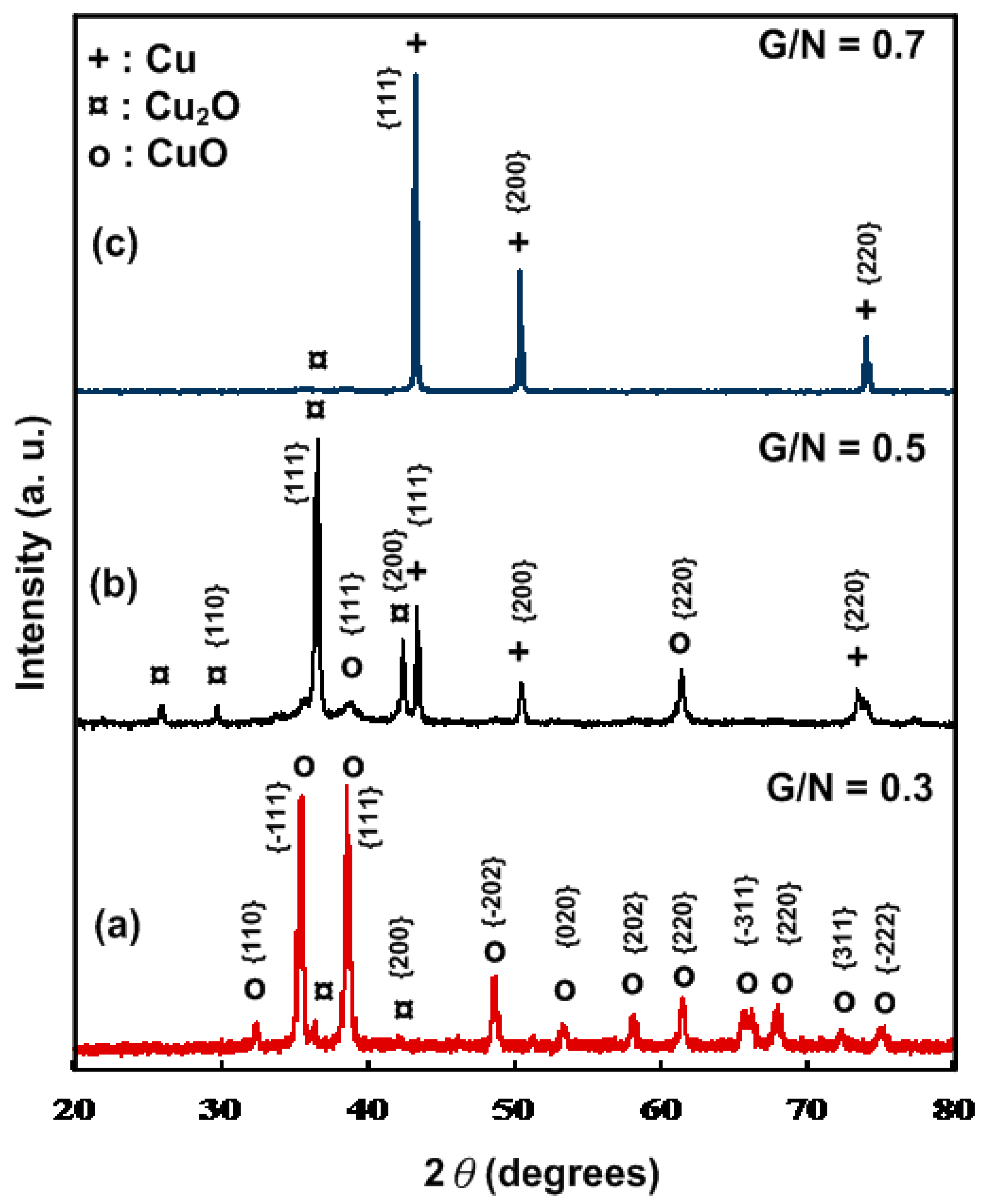
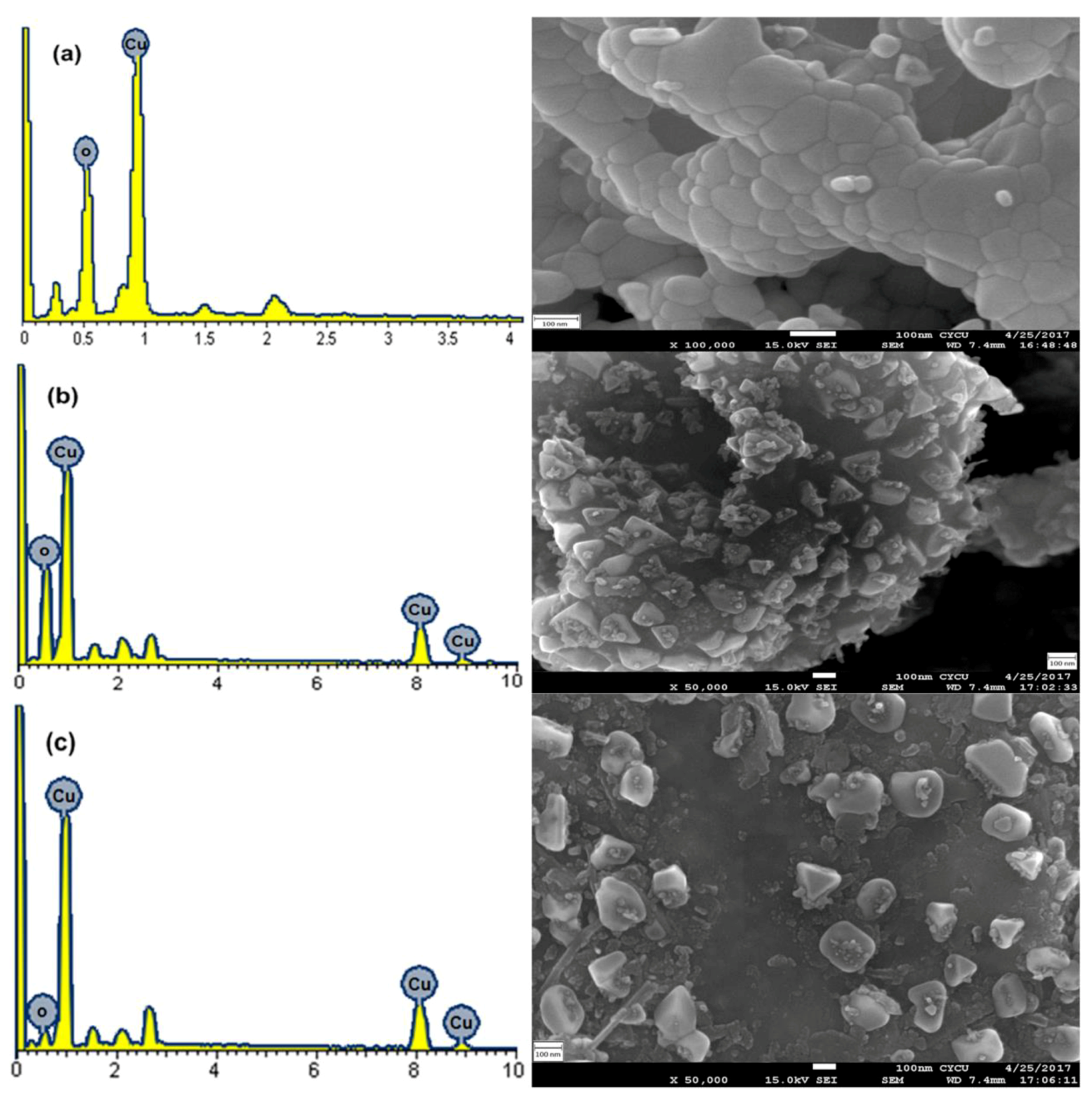
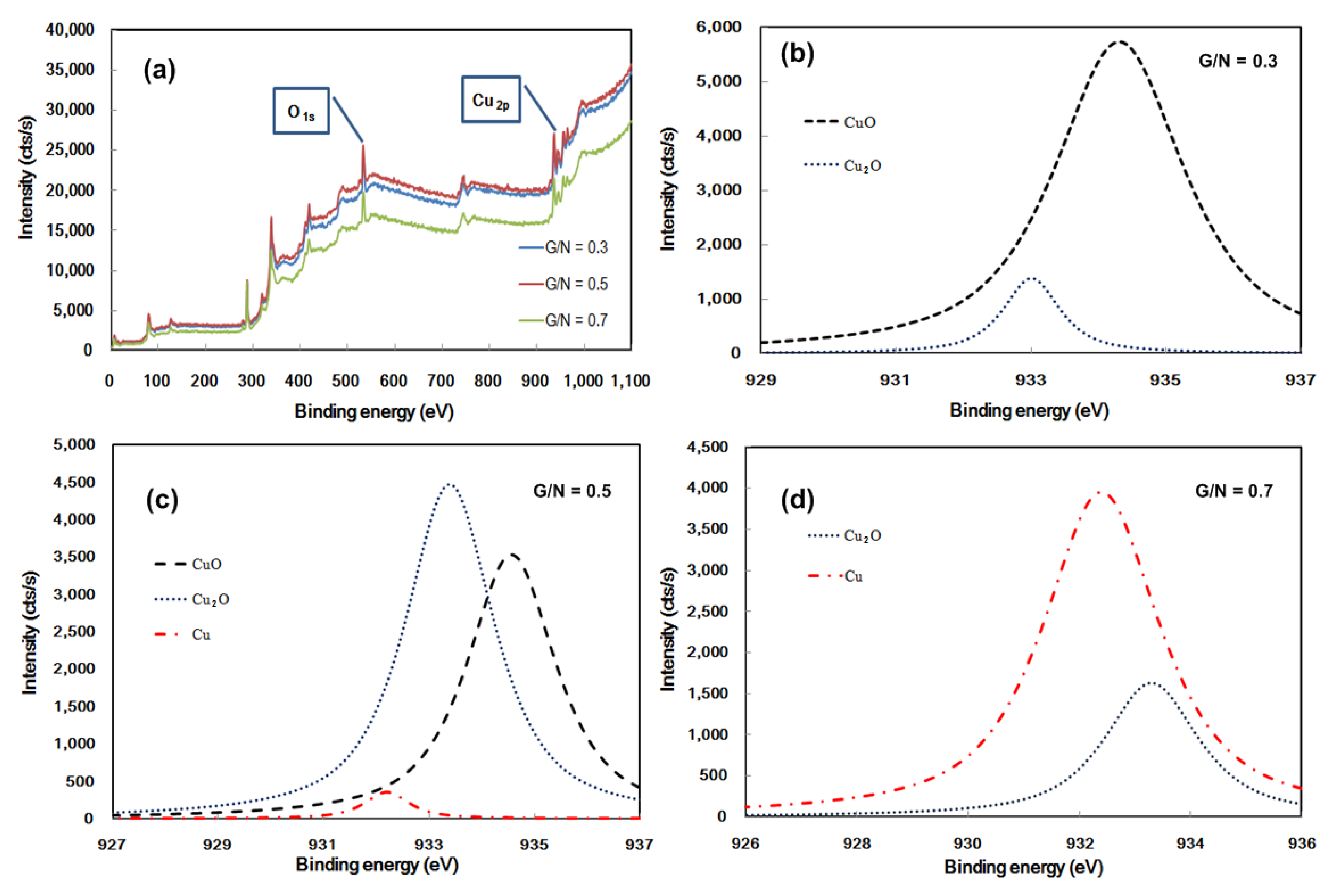
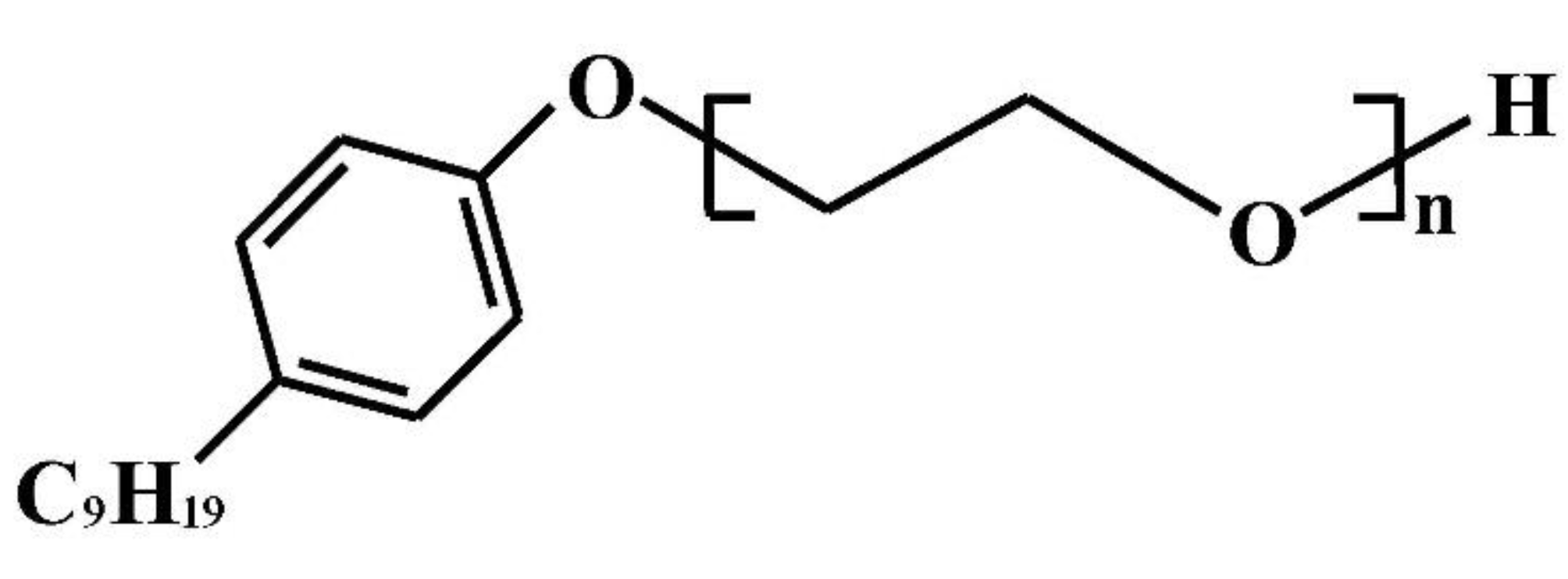
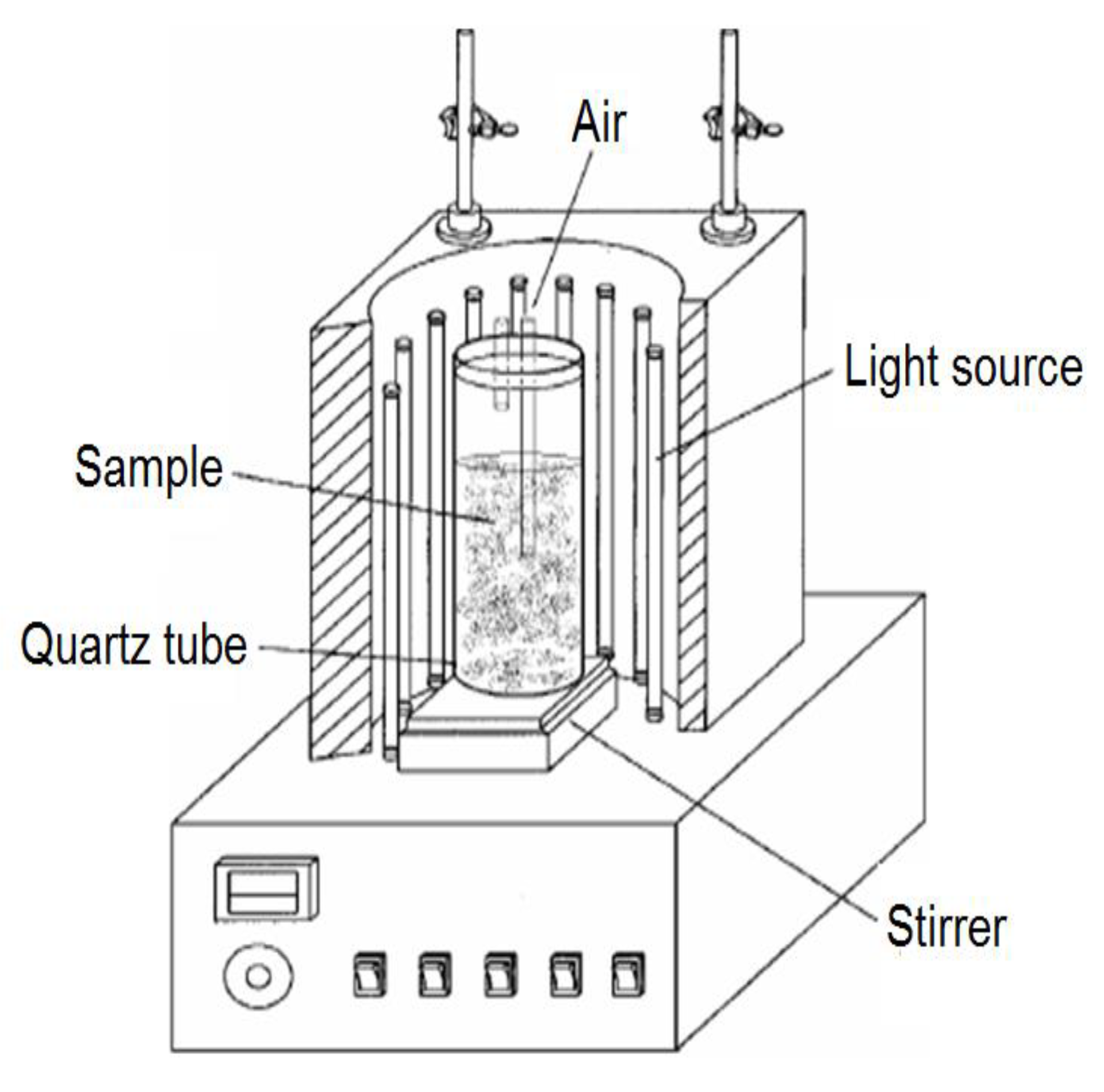

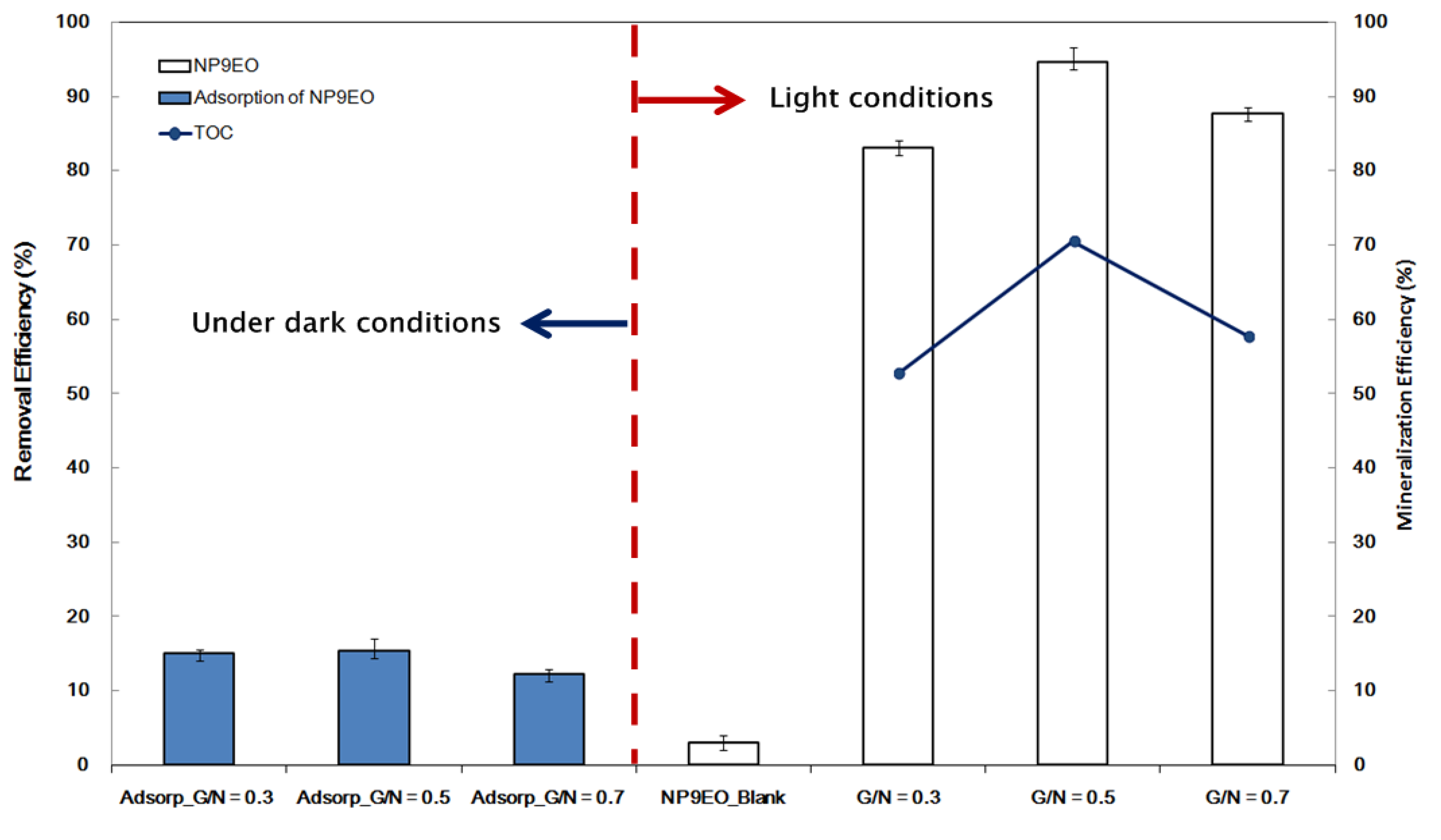
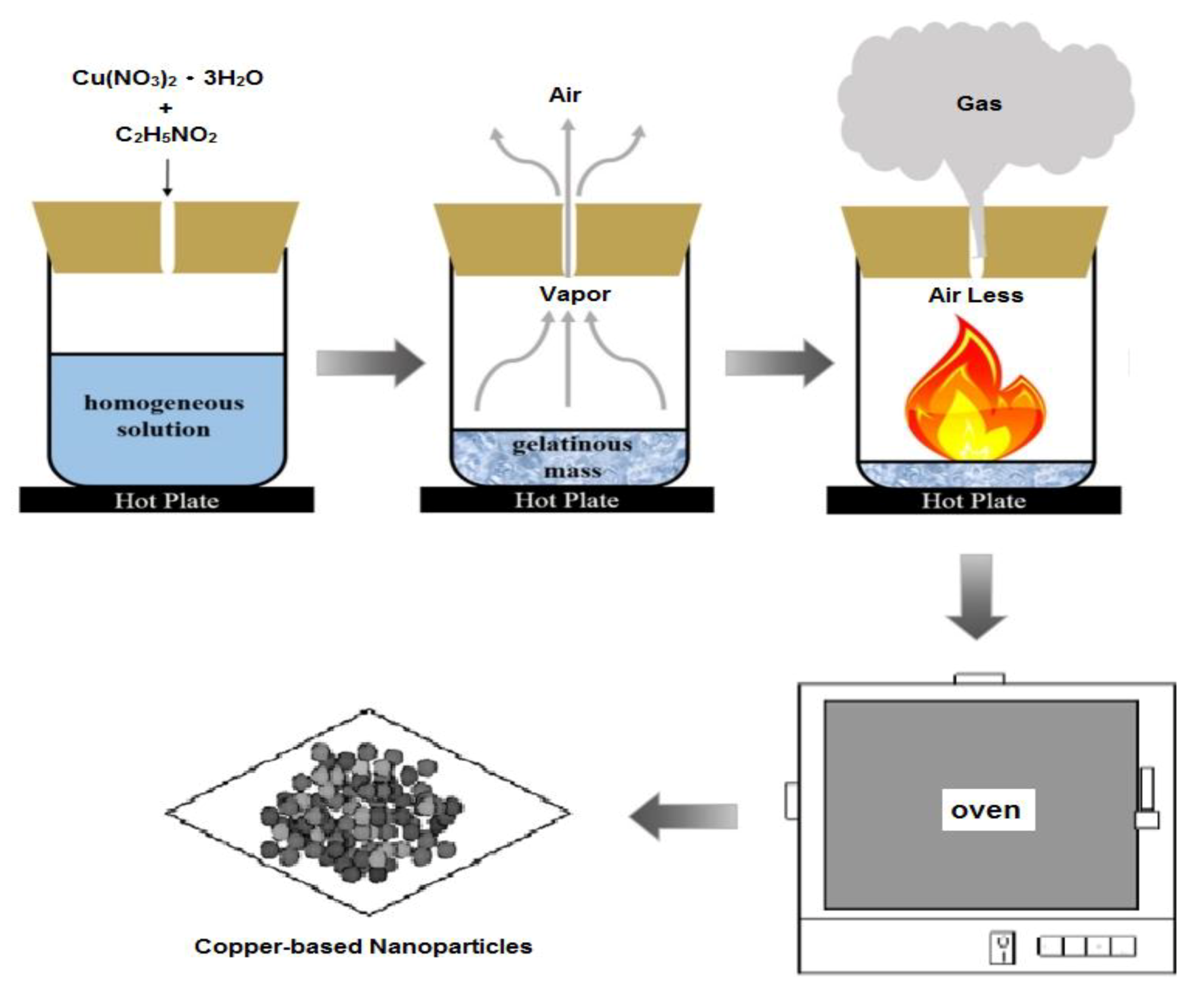
| Catalyst | Synthesis of Copper Oxide Nanoparticles Ratio Analysis [%] | Specific Surface Area (m2 g−1) | Crystallite Size (nm) | ||
|---|---|---|---|---|---|
| CuO | Cu2O | Cu | |||
| G/N = 0.3 | 90.5 | 9.5 | 0 | 166.9 | 76.3 |
| G/N = 0.5 | 43.2 | 54.6 | 2.2 | 131.0 | 35.4 |
| G/N = 0.7 | 0 | 24.8 | 75.2 | 92.1 | 99.4 |
| Source of Variation | Sum of Squares | Df | Mean Square | F Value | p Value | Decision | |
|---|---|---|---|---|---|---|---|
| Catalyst dosage | Between groups | 329.96 | 4 | 82.49 | 62.24 | 4.99 × 10−7 | Significant |
| Within groups | 13.25 | 10 | 1.32 | ||||
| Total | 343.22 | 14 | |||||
| H2O2 concentration | Between groups | 4314.67 | 4 | 1078.67 | 1325.14 | 1.42 × 10−13 | Significant |
| Within groups | 8.14 | 10 | 0.81 | ||||
| Total | 4322.81 | 14 | |||||
| G/N ratios | Between groups | 199.64 | 2 | 99.82 | 62.83 | 9.46 × 10−6 | Significant |
| Within groups | 9.53 | 6 | 1.58 | ||||
| Total | 209.18 | 8 |
© 2020 by the authors. Licensee MDPI, Basel, Switzerland. This article is an open access article distributed under the terms and conditions of the Creative Commons Attribution (CC BY) license (http://creativecommons.org/licenses/by/4.0/).
Share and Cite
Cheng, H.-H.; Chen, S.-S.; Liu, H.-M.; Jang, L.-W.; Chang, S.-Y. Glycine–Nitrate Combustion Synthesis of Cu-Based Nanoparticles for NP9EO Degradation Applications. Catalysts 2020, 10, 1061. https://doi.org/10.3390/catal10091061
Cheng H-H, Chen S-S, Liu H-M, Jang L-W, Chang S-Y. Glycine–Nitrate Combustion Synthesis of Cu-Based Nanoparticles for NP9EO Degradation Applications. Catalysts. 2020; 10(9):1061. https://doi.org/10.3390/catal10091061
Chicago/Turabian StyleCheng, Hsu-Hui, Shiao-Shing Chen, Hui-Ming Liu, Liang-Wei Jang, and Shu-Yuan Chang. 2020. "Glycine–Nitrate Combustion Synthesis of Cu-Based Nanoparticles for NP9EO Degradation Applications" Catalysts 10, no. 9: 1061. https://doi.org/10.3390/catal10091061






